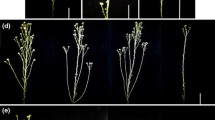Abstract
Conflicting theories of inheritance of branching in guar [Cyamopsis tetragonoloba (L.) Taub.] have been reported. In this study, two lines differing in leaf surface and growth habit were used to make reciprocal crosses and form progeny populations in order to study how basal branching is inherited. Parents in the reciprocal crosses were PI 217923, which is an erect type with pubescent leaves that exhibits predominantly zero, but as many as four basal branches; and ‘Lewis’, which is a branching type with glabrous leaves that exhibits from two to ten branches at the base. Parental and progeny populations were evaluated for branching under field-grown conditions. Effect of plant spacing (seeding rate at 1 seed/cm vs. 1 seed/30 cm) on basal branching of PI 217923 and Lewis was studied. Hybrids were identified by erect branching and pubescent leaf surface. F1 plants had erect branching type and pubescent leaves, indicating that erect branching is dominant to basal branching and there is no maternal effect. Chi-square goodness-of-fit analysis revealed that F2 populations segregated in the expected 3:1 ratio (P<0.10–0.70), indicating that basal branching was controlled by one gene. We propose gene symbol Brh-1 for the gene that controls lack of branching as in segregating populations, Brh-1 is dominant to brh-1. Thus, the genotype of PI 217923 would be Brh-1/Brh-1 or Brh-1/brh-1 as it exhibits erect growth habit with little branching, while that of Lewis would be brh-1/brh-1. When grown at wider plant spacing (1 seed/30 cm), all branching increased, but 3 or 4 basal branches appeared in PI 217923, while the average number of basal branches in Lewis increased from 4.0 to 8.4.
Similar content being viewed by others
Abbreviations
- PI:
-
plant introduction
- USDA-ARS:
-
agriculture research services, United States department of agriculture
- PGRCU:
-
plant genetic resources conservation unit
References
Board JE, Harville BG, Saxton AM (1990) Branch dry weight in relation to yield increases in narrow-row soybean. Agron J 82:540–544
Charles-Edwards DA, Beech DF (1984) On the ordered development of plants 3. Branching by the grain legume Cyamopsis tetragonoloba (Guar). Ann Bot 54:673–679
Chaudhary BS, Paroda RS, Solanki KR (1974) A new crossing technique in cluster bean [Cyamopsis tetragonoloba (L.) Taub. Curr Sci 43:456–459
Chaudhary BS, Lodhi GP (1981) Studies on the inheritance of five qualitative characters in clusterbean [Cyamopsis tetragonoloba (L.) Taub.] Euphytica 30:161–165
Dabas BS, Mittal SP, Singh HB (1977) Inheritance of branching in clusterbean. Indian J Genet 37:460–462
Egli DB (1988) Alterations in plant growth and dry matter distribution in soybean. Agron J 80:86–90
Fletcher R, Murphy H (1998) The New Rural Industries: A Handbook for Farmers and Investors. Canberra, Australia, pp 343–346
Gupta M, Bothara KL, Mittal PN (2003) International conference on advances in guar production and processing. http://www.realbikaner.comguarconference Retrieved on July 24, 2003
Hymowitz T (1963) Studies on guar-Cyamopsis tetragonoloba (L.) Taub. Ph.D. diss. Oklahoma State Univ., Stillwater, OK 74078, USA, pp 87–91
Kahn BA, Nelson WA (1991) Row arrangement can affect yield and pod distribution pattern of trellised snow peas. HortScience 26:532–534
Nelson R (1996) The inheritance of a branching type in soybean. Crop Sci 36:1150–1152
Paroda RS, Saini ML (1978) Guar Breeding. In: Paroda and Arora (eds) Guar – its improvement and management. Forage Res 4:9–39
Rao GVS, Paroda RS (1982) Factor analysis in clusterbean (Cyamopsis tetragonoloba (L.) Taub.). TAG 62:273–276
Ray DT, Stafford RE (1985) Genetic nomenclature in guar. Crop Sci 25:177–179
Sohoo MS, Gill KS (1976) Inheritance of seven qualitative characters in clusterbean Cyamopsis tetragonoloba (L.) Taub. Genet Agric 30:185–190
Russell PJ(1996) Genetics, 4th ed. HarperCollins College Publ, New York, NY
Stafford RE, Lewis CR (1975) Natural crossing in guar, Cyamopsis tetragonoloba (L.) Taub. Crop Sci 15:876–877
Stafford RE, Ray DT (1985) Registration of Lewis guar. Crop Sci 25:365
Stafford RE (1986) Lewis – a new guar variety. Leaflet L-Texas agricultural experiment station, Texas A&M University System. 2177:3
Stafford RE, Seiler GJ (1986) Path coefficient analyses of yield components in guar. Field Crop Res 14:171–179
Stafford RE (1987) Dry-matter accumulation in different guar genotypes under irrigated and dry land conditions. J Agron Crop Sci 158:38–48
Whistler RL, Hymowitz T (1979) Guar: agronomy, production, industrial use, and nutrition. Purdue University Press, West Lafayette, Indiana, pp 36–37
Author information
Authors and Affiliations
Corresponding author
Rights and permissions
About this article
Cite this article
Liu, W., Hou, A., Peffley, E.B. et al. The inheritance of a basal branching type in guar. Euphytica 151, 303–309 (2006). https://doi.org/10.1007/s10681-006-9150-3
Received:
Accepted:
Published:
Issue Date:
DOI: https://doi.org/10.1007/s10681-006-9150-3




